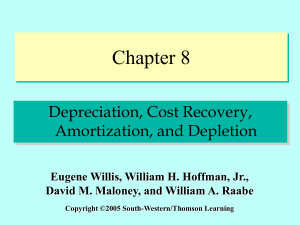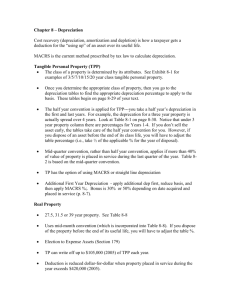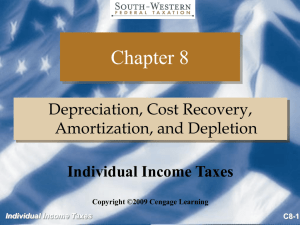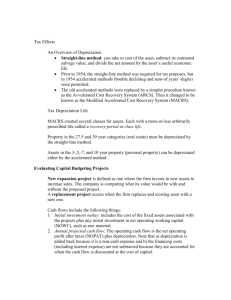C8 - 3 Individual Income Taxes
advertisement
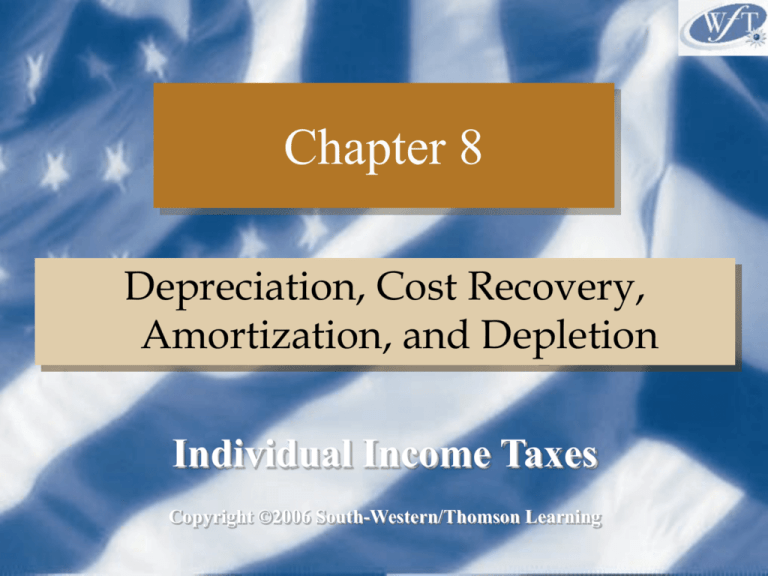
Chapter 8 Depreciation, Cost Recovery, Amortization, and Depletion Individual Income Taxes Copyright ©2006 South-Western/Thomson Learning Cost Recovery • Recovery of the cost of business or incomeproducing assets is through: – Cost recovery or depreciation: tangible assets – Amortization: intangible assets – Depletion: natural resources Individual Income Taxes C8 - 2 General Considerations (slide 1 of 2) • Basis in an asset is reduced by the amount of cost recovery that is allowed or allowable Individual Income Taxes C8 - 3 General Considerations (slide 2 of 2) • MACRS applies to: – Assets used in a trade or business or for the production of income – Assets subject to wear and tear, obsolescence, etc. – Assets must have a determinable useful life – Assets that are tangible personalty or realty Individual Income Taxes C8 - 4 MACRS-Personalty • MACRS characteristics: MACRS Personalty Statutory lives: Method: Convention: 3, 5, 7, 10 yrs 200% DB Half Yr or . 15, 20 yrs 150% DB Mid-Quarter DB = declining balance with switch to straight-line Straight-line depreciation may be elected Individual Income Taxes C8 - 5 Additional 50% Cost Recovery Allowance • For qualified property acquired after 5/05/03 and before 1/01/05, an additional 50% cost recovery allowance is available – Qualified property includes most types of new property other than buildings – Additional 50% cost recovery taken reduces adjusted basis of property – May elect to not take the additional first-year cost recovery Individual Income Taxes C8 - 6 Example—Additional 50% Cost Recovery Allowance • Corporation acquires new five-year property for $10,000 on 01/15/04 – Cost recovery allowance for 2004: 50% additional first-year depreciation ($10,000×.50) $ 5,000 MACRS calculation ($10,000-$5,000)×.20 1,000 Total Cost Recovery $ 6,000 Individual Income Taxes C8 - 7 Additional 30% Cost Recovery Allowance • For qualified property acquired after 9/10/01 and before 9/11/04, an additional 30% cost recovery allowance is available (instead of the 50% additional depreciation) – Qualified property must meet same general requirements as for 50% additional depreciation – Taxpayer may elect to: • Take 30% additional depreciation instead of the 50% additional depreciation • Not take the additional first-year cost recovery Individual Income Taxes C8 - 8 Half-Year Convention • General rule for personalty • Assets treated as if placed in service (or disposed of) in the middle of taxable year regardless of when actually placed in service (or disposed of) Individual Income Taxes C8 - 9 Example: Half-Year Convention • Bought and placed an asset in service on March 15 (Tax year end is December 31) – Treated as placed in service June 30 – Six months cost recovery in year 1 (and year disposed of, if within recovery period) Individual Income Taxes C8 - 10 Mid-Quarter convention • Applies when more than 40% of personalty is placed in service during last quarter of year • Assets treated as if placed into service (or disposed of) in the middle of the quarter in which they were actually placed in service (or disposed of) Individual Income Taxes C8 - 11 Example: Mid-Quarter Convention • Business with 12/31 year end purchased and placed in service the following 5-year class assets (Assume election is made to not take additional 50% or 30% depreciation): Asset 1: on 3/28 for $50,000, and Asset 2: on 12/28 for $100,000 • More than 40% placed in service in last quarter; therefore, mid-quarter convention used: Asset 1: $50,000 × .20 × 200% × 10.5/12 = $17,500 Asset 2: $100,000 × .20 × 200% × 1.5/12 = $5,000 Individual Income Taxes C8 - 12 MACRS-Realty (slide 1 of 2) • MACRS characteristics: MACRS Realty Residential Rental Nonresid. Realty Statutory lives: 27.5 yrs 31.5 yrs or 39 yrs Method: Straight-line Convention: Mid-month Individual Income Taxes C8 - 13 MACRS-Realty (slide 2 of 2) • Mid-month Convention – Property placed in service at any time during a month is treated as if it were placed in service in the middle of the month – Example: Business building placed in service April 25 is treated as placed in service April 15 Individual Income Taxes C8 - 14 Optional Straight-line Election • May elect straight-line rather than accelerated depreciation on personalty placed in service during year – Use the class life of the asset for the recovery period – Use half-year or mid-quarter convention as applicable – Election is made annually by class of property Individual Income Taxes C8 - 15 Election to Expense Assets -Section 179 (slide 1 of 5) • General rules – Can elect to immediately expense up to $105,000 (for 2005) of business tangible personalty placed in service during the year – Cannot use § 179 for realty or production of income property Individual Income Taxes C8 - 16 Election to Expense Assets -Section 179 (slide 2 of 5) • Section 179 general rules – Amount expensed is taken before the 50% or 30% additional depreciation is computed – Amount expensed reduces depreciable basis – Cost recovery available on remaining basis Individual Income Taxes C8 - 17 Election to Expense Assets -Section 179 (slide 3 of 5) • Annual limitations: – Expense limitation ($105,000 for 2005) is reduced by amount of § 179 property placed in service during year that exceeds $420,000 – Example: In 2005, taxpayer placed in service $427,000 of § 179 property. The expense limit is reduced to $98,000 [$105,000 – ($427,000 – $420,000)] Individual Income Taxes C8 - 18 Election to Expense Assets -Section 179 (slide 4 of 5) • Annual limitations: – Election to expense cannot exceed taxable income (before § 179) of taxpayer’s trades or businesses • Any amount expensed under § 179 over taxable income limitation may be carried over to subsequent year(s) • Amount carried over still reduces basis currently Individual Income Taxes C8 - 19 Election to Expense Assets -Section 179 (slide 5 of 5) Example: Taxpayer buys equipment for $300,000 (7-year property) on August 15, 2005 and elects immediate expensing of the maximum amount Cost of equipment $300,000 § 179 deduction 105,000 Amount subject to MACRS $195,000 MACRS rate .1429 Cost recovery allowance $ 27,866 • Total cost recovery allowed in 2005 is $132,866 ($105,000 + $27,866) Individual Income Taxes C8 - 20 Listed Property (slide 1 of 4) • There can be substantial limits on cost recovery of assets considered listed property • Listed property includes the following: – Passenger automobile – Property used for entertainment, recreation, or amusement – Computer or peripheral equipment – Cellular telephone Individual Income Taxes C8 - 21 Listed Property (slide 2 of 4) • To be considered as predominantly used for business, business use must exceed 50% • Use of asset for production of income is not considered in this 50% test • However, both business and production of income use percentages are used to compute cost recovery Individual Income Taxes C8 - 22 Listed Property (slide 3 of 4) • To be considered as predominantly used for business (cont’d) • If 50% test is met, then allowed to use statutory percentage method of recovery with some limitations Individual Income Taxes C8 - 23 Listed Property (slide 4 of 4) • If asset is not used predominantly for business i.e., business use does not exceed 50% – Must use straight-line method – 30% or 50% additional first-year depreciation not available – If business use falls to 50% or lower after year property is placed in service, must recapture excess cost recovery Individual Income Taxes C8 - 24 Passenger Auto Cost Recovery Limits (slide 1 of 7) For autos placed in service in 2004, cost recovery limits are: Year Recovery Limitation 1 $2,960 2 4,800 3 2,850 Succeeding years until the cost is recovered 1,675 Individual Income Taxes C8 - 25 Passenger Auto Cost Recovery Limits (slide 2 of 7) • Limits are for 100% business use – Must reduce limits by percentage of personal use • Limit in the first year includes any amount the taxpayer elects to expense under § 179 Individual Income Taxes C8 - 26 Passenger Auto Cost Recovery Limits (slide 3 of 7) Example: Taxpayer acquired an auto in 2005 for $30,000 and used it 80% for business 2005 cost recovery allowance: $30,000 × .20 $6,000 Deduction is limited to × Business use % Cost recovery allowance $2,960 .80 $2,368 Individual Income Taxes C8 - 27 Passenger Auto Cost Recovery Limits (slide 4 of 7) • Limit on § 179 deduction – For certain vehicles not subject to the statutory dollar limits imposed on passenger automobiles the § 179 deduction is limited to $25,000 • The limit applies to sport utility vehicles with an unloaded GVW rating of more than 6,000 pounds and not more than 14,000 pounds Individual Income Taxes C8 - 28 Passenger Auto Cost Recovery Limits (slide 5 of 7) • Listed property that fails the >50% business usage test in year property is placed in service must be recovered using the straight-line method • If the >50% business usage test is failed in a year after the property is placed in service, straight-line method must be used for remainder of property’s life – Cost recovery of passenger auto under straight-line listed property rule still subject to annual limits Individual Income Taxes C8 - 29 Passenger Auto Cost Recovery Limits (slide 6 of 7) • Change from Predominantly Business Use – If the business use percentage falls to 50% or lower after the year the property is placed in service, the property is subject to cost recovery recapture – The amount recaptured as ordinary income is the excess cost recovery • Excess cost recovery is the excess of the cost recovery deduction taken in prior years using the statutory percentage method over the amount that would have been allowed if the straight-line method had been used Individual Income Taxes C8 - 30 Passenger Auto Cost Recovery Limits (slide 7 of 7) • Leased autos subject to “inclusion amount” rule – Using IRS tables, taxpayer has gross income equal to each lease year’s inclusion amount – Purpose is to prevent avoidance of cost recovery dollar limits applicable to purchased autos by leasing autos Individual Income Taxes C8 - 31 Alternative Depreciation System (ADS) (slide 1 of 2) • ADS is an alternative depreciation system that is used in calculating depreciation for: – Alternative minimum tax (AMT) – Assets used predominantly outside the U.S. – Property owned by the taxpayer and leased to tax exempt entities – Earnings and profits Individual Income Taxes C8 - 32 Alternative Depreciation System (ADS) (slide 2 of 2) • Generally, use straight-line recovery without regard to salvage value – For AMT, 150% declining balance allowed – Half-year, mid-quarter, and mid-month conventions still apply Individual Income Taxes C8 - 33 Amortization • Can claim amortization deduction on § 197 intangibles – Use straight-line recovery over 15 years (180 months) beginning in month intangible is acquired • Section 197 intangibles include acquired goodwill, going-concern value, trademarks, trade names, etc. Individual Income Taxes C8 - 34 Depletion (slide 1 of 4) • Two methods of natural resource depletion – Cost: determined by using the adjusted basis of the resource and allocating over the recoverable units – Percentage: determined using percentage provided in Code and multiplying by gross income from resource sales Individual Income Taxes C8 - 35 Depletion (slide 2 of 4) • Cost depletion – Depletion is computed on a per unit basis – Per unit amount is determined by dividing the basis of the resource by the estimated recoverable units of resource • Number of units sold in year × per unit depletion = depletion for year – Total depletion can not exceed total cost of the property Individual Income Taxes C8 - 36 Depletion (slide 3 of 4) • Percentage depletion – Depletion is computed by using the statutory percentage rate for the type of resource – Rate is applied to the gross income from the property Individual Income Taxes C8 - 37 Depletion (slide 4 of 4) • Percentage depletion – Percentage depletion cannot exceed 50% of the taxable income (before depletion) from the property – Percentage depletion reduces basis in property – However, total percentage depletion may exceed the total cost of the property • Example: Property with zero basis but still generating income Individual Income Taxes C8 - 38 Intangible Drilling Costs (IDC) • Intangible drilling costs include – Costs for making the property ready for drilling – Costs of drilling the hole • Treatment of IDC – Expense in the year incurred, or – Capitalize and write off through depletion • It is generally advantageous to write off IDC immediately Individual Income Taxes C8 - 39 If you have any comments or suggestions concerning this PowerPoint Presentation for West Federal Taxation, please contact: Dr. Donald R. Trippeer, CPA TRIPPEDR@oneonta.edu SUNY Oneonta Individual Income Taxes C8 - 40
